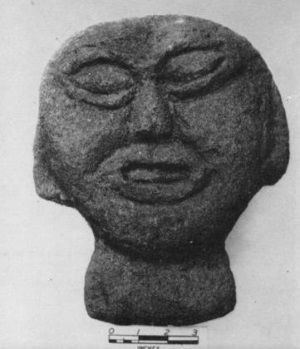Ulster’s Beltany - A 5000-year-old Monument to a Living Celtic Holiday
These are excerpts from an article originally posted October 2016. The full article, which discusses the connection between the Beltane Stone Circle and Beltane worship is linked below:
Beltane observances, the most famous being the beltane Festival held annually in Edinburgh April 30th through May 1st, survive into modern times. Beltane being one of the four annual feast days of the Celts, has survived due in part to its simplicity. The celebrations historically included the lighting of bonfires, a tradition surviving into modern times throughout the presnt day Celtic Nations.
Beltany Stone Head found at the site. An Iron Age stone carving which most likely depicts a Celtic god.

To the southwest of the Ulster city of Derry (Doire) in County of Donegal, near the town of Raphoe, is a Neolithic Celtic monument known as the Beltany Stone Circle. The Beltany Stone Circle is estimated to have been constructed approximately 5000 years ago based on recent archeological research funded by the Irish Heritage Council. Dating Beltany from about 3000 BC makes this monument older than Stonehenge and the Egyptian pyramids (some published sources conversely date the construction of the stone circle at between 1300 and 800 BC).
Eileen Battersby in a November 2005 article in the Irish Times on visiting the site portrayed the aspect of the Beltany Stone Circle as follows:
One of five such monuments in a county rich in archaeology, and one of the finest in Ireland, it overlooks what was once the ancient territory of Magh Itha. Aloof, imposing, and profoundly spiritual, this great stone circle, once a ritual or ceremonial site, is as old as Newgrange. As its name suggests, Beltany must have had associations with the Celtic feast of Beltaine (also spelt Bealtaine), celebrated each year on May 1st and part of pastoral life devised to encourage the summer growth. It is also believed that, in common with Newgrange, there is evidence of astronomical alignment involving two sets of two stones. One of the alignments takes place at sunrise in early May, the other corresponds with the winter solstice. Beltany Stone Head
The web site “ChooseIreland” (linked below) describes the Beltany Stone head as follows:
This Iron Age stone carving depicting what is most likely a Celtic god was found in fields near Raphoe some decades ago. The best-known example among many ancient stone idols found in the Raphoe area, its stylized features and the presence of a neck-ring or torc suggests it is from the late Iron Age period, or around 2,000 years old. Known as The Beltany Stone Head, historians believe this and other idols indicate the stone circle was used for centuries — even thousands of years — after its original construction. They believe the stone head may have been used in ritual practices at the Circle — perhaps to ward off evil spirits. The artifact is now located at the National Museum in Dublin. There is also a replica on display in the Donegal County Museum in Letterkenny.
Original Article:https://www.transceltic.com/irish/ulsters-beltany-5000-year-old-monument...






